Appalachia

In 2014, Shepherdstown Presbyterian Church in West Virginia installed an array of 60 solar panels with a scrappy financial model, hoping to lead by example and inspire other communities in Appalachia to transition to solar energy as well.
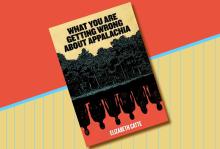
ELIZABETH CATTE'S What You Are Getting Wrong About Appalachia is the vindication every Appalachian has been craving in the wake of the media’s seemingly endless examination of so-called “Trump Country.” For any native Appalachian like me, reading this slim volume is at once a breath of fresh air and the blueprint you always wished for to respond when someone snidely expresses surprise that you have all your teeth and a good pair of shoes.
Catte divides her book into three sections. First, she provides an overview of why Appalachia is more diverse and less monolithically conservative than the media has portrayed. Second, Catte offers a direct refute to the Trump Country literary genre. The author concludes her work with a powerful description of her Appalachian home’s core values, contrasting Appalachians’ longstanding commitments to social justice and cohesive community against outsiders’ efforts to both “save” the region’s people and extract its resources without just compensation or stewardship.
Catte frankly describes her mission in writing this book as providing “critical commentary about who benefits from the omission of [diverse Appalachian] voices ... and openly celebrat[ing] the lives, actions, and legacies of those ignored in popular commentary about Appalachia.”

In this environment, it has been easy to overlook what in any normal week would be a top story. Since Feb. 22, West Virginia public school teachers and employees have been forcing the state's 55 county boards of education to shut down, citing inadequate pay and climbing health insurance costs. That is every teacher, every public school, in the entire state. Though a strike of this scale is extraordinary, it is not without precedent. In 1990, West Virginia teachers in 47 counties stopped work and earned an across-the-board $5,000 pay increase for teachers throughout the state.
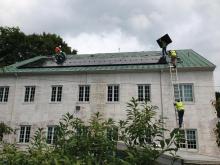
JUST A FEW YEARS AGO, Dan Conant was living a life familiar to generations of West Virginians. Born and raised in the state’s Eastern Panhandle, he’d gone to college and left West Virginia to build a career for himself. But Conant, who was working on community solar panel projects in Vermont, couldn’t shake the feeling that he was needed back home, where the shuttering of the coal industry threatened the few employment opportunities that remained.
“It was almost too easy in Vermont,” he recalled. “I needed to be back in West Virginia.”
In 2013, he and his wife, Laura Nagel, a Pittsburgh native, returned to Jefferson County and “Solar Holler,” a crowd-funded venture that installs solar panels for no cost at nonprofits, was born.
“Free, local electricity allows [nonprofits] to put resources toward what matters—including taking care of our neighbors—and creation,” the organization explains on its website.
Solar Holler’s unique crowd-funding model is designed to function within the restrictions of West Virginia’s power industry legislation that, unsurprisingly, favors coal. Nationally, the solar industry relies on tax credits, for which nonprofits in West Virginia are ineligible. Solar Holler’s early efforts to circumvent this barrier—by selling solar panels directly to a church—were shut down by state lawmakers.
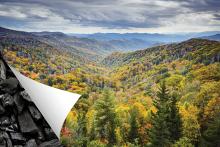
ON A HOT DAY in summer 2015, Michael Iafrate stared in distress out the window of a tiny Cessna flying over his native West Virginia.
“What I felt,” he said later, “reminded me of what it’s like when you’re driving along a highway and come upon a bad crash. That twist in your gut, knowing that death is happening here.”
Below him was the Hobet Mine site, 10,000 acres of what was once thickly forested mountains but is now a flat and desolate moonscape—the result of three decades of mountaintop removal mining and one of many such sites that now dot the Appalachian landscape.
“It just kept going and going, mile after mile after mile of blank, ravaged land,” said Iafrate, a 39-year-old doctoral student in theology at the University of Toronto’s St. Michael’s College. Flying so close over the scarred landscape that unrolled below the plane, Iafrate thought of the apostle Thomas touching the wounded side of Jesus. “It felt like an encounter with some wounds of Christ on the earth.”
Iafrate’s flight—provided by SouthWings, a small nonprofit group of pilots that advocates for environmental preservation by providing bird’s-eye views of the results of inaction—was one step in a project he’d been engaged in for several years. But it effectively brought many hours of research and writing into a harsh and visceral focus.
There was more to Iafrate’s anxiety than topography. There was also history, because the text he was working on would become a follow-up to one of the most significant ecclesial statements in U.S. Catholic history. Both the land and the past insisted: He had to get this right.
Listening to the poor in This Land
Back in 1975, the Catholic bishops of Appalachia—a swath of territory, marked by intransigent poverty, that stretches from the northern sections of Mississippi and Alabama up to central New York state—published a major pastoral letter on “powerlessness” in the region. This Land Is Home to Me was the fruit of much groundwork by a group of committed laypeople, religious, and clergy called the Catholic Committee of Appalachia (CCA).
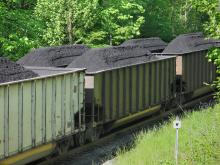
WEST VIRGINIA’S coal-addicted economy is busted. Dozens of bankrupt coal companies are busted. A coal company CEO is busted for flagrant safety violations that contributed to an explosion killing 29 miners.
Boom-and-bust cycles have a jagged history in the central Appalachian coal basin of southern West Virginia, eastern Kentucky, and southwest Virginia. America’s industrial revolution prospered on Appalachia’s steam and coking coal. Hard-gained union struggles brought miners and their communities an improved living standard. Yet as time marched on, machinery replaced miners, the coal industry busted unions, Appalachian coal seams played out, and cheaper Western coal and fracked shale gas outcompeted.
Coal-dependent economies are now tanking. Miner layoffs have skyrocketed. Policymakers have long ignored forecasts of coal’s impending decline. The West Virginia legislature, facing a major state revenue shortfall, is considering drastic budgetary cuts—such as closing state parks, college branch campuses, and state police detachments—while, incredibly, introducing bills to attempt to bring back the coal industry by reducing its severance and worker-compensation taxes.
Coal will not bounce back. From coal’s perspective, the national debate on coal and climate change has largely been lost.
The Clean Power Plan announced by the EPA in June 2014 seeks to reduce climate-warming CO2 emissions 30 percent by 2030. Projected air quality improvement will also deliver significant financial and life-protecting health benefits. However, since West Virginia politicians dance to the strings of their coal-industry puppet masters, State Attorney General Patrick Morrisey is leading a coalition of 25 states asking a federal court to strike down the Clean Power Plan, calling it a “war on coal.”

OUT WHERE Kentucky meets West Virginia, you’ll find one of America’s cultural seedbeds, where Scotch-Irish immigrant traditions took root in the New World. But on her debut album, American Middle Class, singer-songwriter Angaleena Presley, a daughter of the Kentucky mountains (and no kin to The King), paints a heartbreaking picture of what Appalachia has become.
The people of this region were once mostly self-sufficient subsistence farmers. In the early 20th century, they were drafted into the coal mines but brought their pride and independence with them, waging often-bloody battles to establish the United Mine Workers of America. For over a century now, the region’s economic fate has been hostage to the ups and downs of the energy market. As a result, the coal fields have become one of the poorest parts of the country.
The music that flourished in this region became, along with that of low-country African Americans, one of the two great pillars of American popular music. So many country music greats have come from here that Kentucky has a “Country Music Highway Museum” just to honor all the stars (Loretta Lynn, Ricky Skaggs, Billy Ray Cyrus, Keith Whitley, and many others) born along U.S. 23.

Two weeks ago in Soma, Turkey, a coal mine explosion left 301 people dead. It was the country’s worst mining disaster, but it wasn’t the first — and it wasn’t the last, as multiple fatal accidents have happened in the two weeks since. The last time a mining disaster caught the world’s attention, we watched and waited and prayed during the rescue operation for the miners in Chile.
In Turkey, people protested in the streets of Soma — protested against Soma Mining for letting this happen, against their government for loopholes in safety rules. In response, the police issued a ban on protests and locked the city down. The ruling political party proudly announces that it has inspected that mine 11 times in the past 5 years; Soma Mining denies negligence. And the families of 301 persons mourn their losses.
This isn’t a faraway problem. In the United States, we don’t do as much traditional mining as we used to — instead, we do mountaintop removal. This has a human cost, too, in more insidious ways. The people living in Appalachia have higher rates of respiratory illness, cancer, kidney diseases, skin ailments, and more. And the landscape, which has the fingerprints of God in it, is being blown apart.
Psalm 95:4-5 says:
“In [God’s] hand are the depths of the earth; the heights of the mountains are [God’s] also. The sea is [God’s], for [God] made it, and the dry land, which [God’s] hands have formed.”
“THE CHURCH radicalized me,” celebrated author and ordained Episcopal deacon Denise Giardina once said, describing how she sees herself as both social activist and servant minister. “The phrase in the prayer book is ‘Interpret the world to the church and the church to the world.’ It’s a totally different way to advocate, with a spiritual point of view.”
This philosophy has shown up in her bestselling novels, published over her long career, such as Storming Heaven (1987) and The Unquiet Earth (1992), which chronicle the history and social impacts of coal mining in Giardina’s native Appalachia; Saints and Villains (1999), which tells the story of Dietrich Bonhoeffer’s resistance against Hitler and the Nazis; and, most recently, Emily’s Ghost (2010), a reimagining of Emily Brontë’s story and how her life was changed by her encounter with an ardent member of the clergy.
Shortly before her recent retirement from teaching creative writing at a West Virginia college, Giardina talked with Jason Howard, author of A Few Honest Words and coauthor of Something’s Rising, about her literary career, social justice activism, and her time in the late 1970s in Washington, D.C., as a member of Sojourners community (the intentional Christian community that founded Sojourners magazine and other ministries).

ON THE 2001 album Southern Rock Opera, over a thumping four-by-four beat and three roaring guitars, Drive-By Truckers front man Patterson Hood sang a song about “the duality of the Southern thing,” which he identified as equal parts “glory” and “shame.”
That pretty much sums up the paradox of a place like Hood’s native Alabama, where they celebrate the birthdays of Martin Luther King Jr. and Robert E. Lee on the same day. But up in the northwest corner of Alabama there stands a monument to the South’s unalloyed glory—the FAME recording studio in Muscle Shoals.
Beginning in the late 1950s, when segregation was still the law throughout the former Confederacy, at FAME black and white Southerners worked as partners, side by side, to make the sweet soul music that would help change the world. Percy Sledge’s “When a Man Loves a Woman,” Aretha Franklin’s “I Never Loved a Man the Way I Love You,” Wilson Pickett’s “Land of 1,000 Dances” and “Mustang Sally”—they were all recorded in Muscle Shoals within a two-year period in the mid-1960s.
And most of the musicians on all those deeply funky recordings were white Alabamans. The bass player, David Hood, was the father of the Truckers’ Patterson Hood.
That’s the story told in Greg “Freddy” Camalier’s film Muscle Shoals, premiering on the PBS series “Independent Lens” on April 21. The film features FAME founder Rick Hall, the FAME rhythm section of Roger Hawkins, Barry Beckett, Jimmy Johnson, and Hood (the boys Lynyrd Skynyrd dubbed “The Swampers”), and some of the artists who came to work with them—Aretha Franklin, Wilson Pickett, Percy Sledge, Mick Jagger, Keith Richards, and others. Musicians of more recent vintage testify to the abiding influence of the Muscle Shoals sound—such as Bono, Alicia Keys, and John Paul White, a local boy who found fame with The Civil Wars. And it’s all shot against the backdrop of the Muscle Shoals area’s wooded hills, lowland cotton fields, and, most of all, the magnificent Tennessee River upon which the life of the region still depends.

SOON AFTER Dr. Michael Hendryx assumed a professorship of health policy management at West Virginia University, he started hearing stories of sick people in Appalachian communities near mountaintop removal coal mining operations. Finding no scientific research that examined the correlation between mountaintop removal and community health, Hendryx and his colleagues began overseeing family health surveys and compiling health data from the Centers for Disease Control and Prevention.
Since 2011, Peter Illyn of Restoring Eden (Christians for Environmental Stewardship) has recruited and led student volunteers from Catholic and evangelical Christian colleges in conducting door-to-door community health surveys for Hendryx’s research. Typical volunteer experiences, according to Illyn, include “aha” epiphanies and deepening conversions to God’s justice. Alex Gerrish, a recent Samford University (Birmingham, Ala.) graduate, recalls a searing experience. Her survey team visited a home located close by two mountaintop removal (MTR) operations, where a mother answered the door. She said, “I’m trying to get my son down for a nap,” explaining that her two-year-old had a heart defect. “Now’s not a good time to talk.” Two days later the team revisited the home to be met by an older, tear-stained woman. “I’m sorry,” she said. “My grandson passed away a couple days ago.” He never woke up from his nap. As Gerrish stood in shock, she recalled the statistics on high birth-defect rates in communities with mountaintop removal operations.
Now, more than two dozen published peer-reviewed studies show a high correlation between populations living amid MTR operations and very high rates of morbidity, asthma, chronic obstructive pulmonary disease, heart disease, cancer, and birth defects.
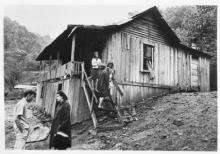
HOT SPRINGS, N.C. — The 50th anniversary of President Lyndon Johnson’s launch of the War on Poverty, which falls today, reminds us how intractable that effort can be, despite the hope and determined idealism when the legislation was signed.
Appalachia was one of the targets for the newly established Office of Economic Opportunity, utilizing programs such as Head Start and Volunteers in Service to America (VISTA). The anniversary also recalls how religion has motivated, shaped and sustained this effort, in many ways prefiguring the campaign, in both its successes and failures.
For more than two centuries, these Southern mountains have been a magnet for missionaries, both religious and secular, all determined to wipe out poverty, hunger, and ignorance — whether the region’s benighted folk wanted them to or not. Their too-common failing, local people say, is that the erstwhile do-gooders have not respected the strong beliefs and culture that already existed.
With the best intentions, altruists and uninvited agents of uplift have come with their social gospel of “fixing” local people. That is to wean them from violence and the debilitating use of alcohol, while bringing their brand of faith, along with education, nutrition, and improved living standards. Invariably well-meaning, these efforts have typically ended in disappointment and failure in places such as Madison County, N.C.
Reverend Billy and the Church of Earthalujah! has pulled it off again, this time in Swarthmore, Pennsylvania.
Those of us living along the Gulf Coast are the sacrificial people and region for you and the rest of the Western world. We have been for many many generations. Sociologists would call us the subaltern; politicians would call us the 'don't counts'; economists call us disposable; geographers call us 'ineducable'; religious people call us hedonists or sinners; educators call us backwards.